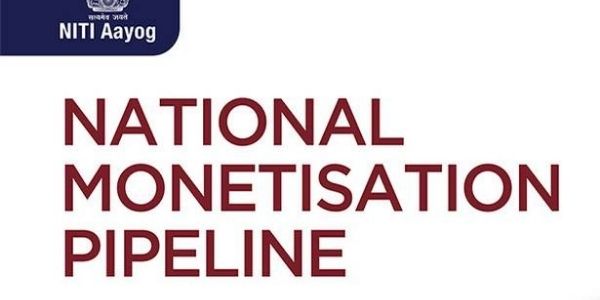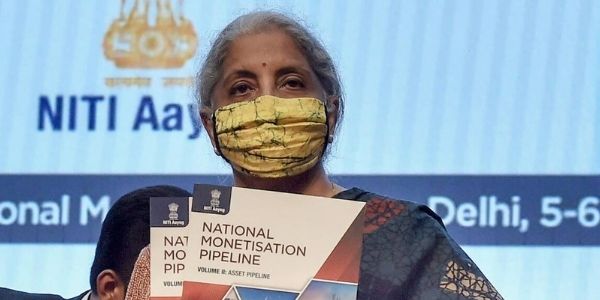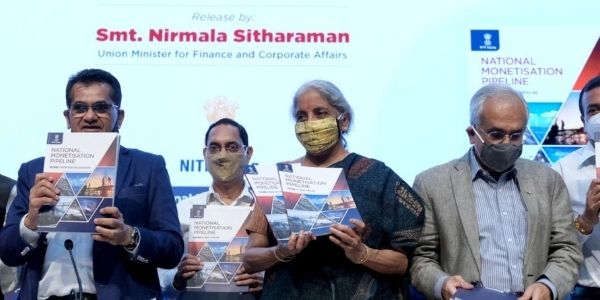This article has added all information related to the National Monetisation Pipeline (NMP). Know about the National Monetization Pipeline in India, asset monetization meaning, and all other details. Further, it is one of the vital concepts for the IAS exam. Besides, as a part of the IAS exam GS papers, it is one of the important topics for the UPSC exam. Therefore, covering the complete syllabus is important to get the best results in the IAS exam. One can read the complete article and know about the National Monetisation Pipeline.

Introduction
The National Monetisation Pipeline (NMP) envisages an aggregate monetization potential of ₹6-lakh crore. It launched to list the government’s infrastructure assets to be sold over the next four years.
Monetization is the government is basically transferring revenue rights to private parties for a specified transaction period. Further, below we have covered all the essential factors related to the NMP, asset monetization meaning in India, and other important factors that will help you with the IAS exam.
National Monetisation Pipeline
As we have mentioned earlier, the NMP program is for four years. It will do so by engaging the private sector, transferring to them the rights, and using the funds for infrastructure creation across the country.
Key Points of the Monetization in India
The NMP aims to unlock value in brownfield projects by engaging the private sector, transferring revenue rights, and no ownership in the projects. Further, using the funds generated for infrastructure creation across the country. In addition, the NMP has been announced to provide a clear framework for monetization and give potential investors a ready list of assets to generate investor interest. The NMP will run a co-terminus with the Rs 100 lakh crore National Infrastructure Pipeline (NIP) announced in December 2019.
Provisions of the NMP
Real estate investment trusts and infrastructure investment trusts are structures used to monetize assets in the roads and power sectors. Further, the NITI Aayog, in coordination with the Finance Ministry, has created the NMP dashboard and the detailed roadmap.

Sectors Involved in NMP
Below we have mentioned the top 5 sectors in value capture, around 83 percent of the aggregate pipeline value.
- Roads – 27 percent
- It consists of 26,700 km of roads, railway stations, train operations, and tracks
- Railways – 25 percent
- Power – 15 percent
- 28,608 CKT km worth of power transmission, 6 GW of hydroelectric and solar power assets will be monetised.
- Oil & gas pipelines – 8 percent
- 8,154 km of natural gas pipelines and 3,930 km of petroleum product pipelines are up for the bid.
- Telecom – 6 percent.
- 2.86 lakh of km fiber assets and 14,917 towers in the telecom sector are opened up for the private sector.
- Further, the rest will be for sectors like mining, aviation, ports, warehouses, and stadiums. Besides, it has 15 railway stadiums, 25 airports, and the stake of the Central government in current airports and 160 coal mining projects, 31 projects in nine major ports, 210 lakh MT of warehouses.
Objectives of the National Monetisation Pipeline
- In the first place, it aims to provide a clear framework for monetization and give potential investors a ready list of assets to generate their interest.
- Further, it aims to monetize the existing asset base and use its proceeds for new infrastructure creation.
Significance of Asset Monetization Meaning
- In the first place, it helps in boosting the economy. It helps in generating better employment opportunities and drives the competitiveness of the Indian economy.
- Further, in utilizing underutilized Public Assets. It also supports sectors like coal, crude oil, natural gas, refinery products, fertilizers, steel, cement, and electricity.
Challenges
- Low Level of capacity usage in gas and petroleum pipeline networks, regulated tariffs in power sector assets
- Further, the taxpayers have already paid for public assets, so, why should they pay again to a private party to use them.
- A criticism of the NMP is that the transfer would end up creating monopolies, leading to a rise in price.
- Analysts also point to problems like the lack of independent sectoral regulators as potential impediments.
Benefits of National Monetization Pipeline in India
The National Monetisation Pipeline helps the creation of capital assets and meets the infrastructure requirements of the nation. It also ensures resource efficiency in infrastructure operations and maintenance. In addition, it reduces the risk for the private sector as these are brownfield projects. Government-led capital creation has been a significant force globally to overcome the economic slowdown induced by the COVID-19 pandemic. Also, it works towards ensuring a transparent mechanism for public authorities to monitor the performance of the private players.

Measures
- Structuring the deals
- Preventing a monopoly
- Smooth implementation
- Proper regulation
Concerning the future, it will help in Strengthening Public Enterprises. Strengthening the judicial processes can not be much emphasized.
IAS Exam Suggestions
Now let us understand all details related to the IAS exam. Further, we have added all details of the IAS exam. Click Here and learn about the IAS exam syllabus, pattern, books, and other information. Besides, below we have added some suggestions that you can use during the IAS exam preparations.
- First, one must know the exam syllabus and the pattern of the paper. It is the first thing to refer to the last year’s question papers.
- You can also give mock tests that will help you understand your skills and improve the same.
- Time management is one of the important things in any exam. So, make a proper timetable and give time for all subjects, including revision. Revision is an essential part of the IAS exam, and we suggest you revise the old concepts before starting the new concept.
- Further, one must try to solve as many question papers as possible. It will help you to know about the trending topics, marks, patterns, and other details.
- One must also have a habit of resing newspapers daily. However, there are many applications available on mobile these days, so you can download one and study the same.
- Besides, have a habit of writing notes. One needs to write points while studying nay topic, and you can study the same during the exam.
- Answer writing practice is again one of the important factors for the exam. As questions asked in the IAS, the main exams are descriptive types. One must also practice writing along with studying for the exam.
- Lastly, one must check the official website regularly to know about the latest updates related to the exam. Click Here
Conclusion – National Monetisation Pipeline

In summary, this article will help you provide all information related to the National Monetization Pipeline in India (NMP) and its asset monetization meaning. As a whole, it will help deliver socio-economic growth and quality of life to the country’s people. Further, to enable infrastructure creation through monetization where the public and private sectors collaborate and excel in their core competence areas. Besides, get all information related to the other IAS exam study materials here. We have tried covering all details about various important things for the IAS exam. We all know about the IAS UPSC Exam and the IAS exam syllabus. Many aspirants wish to become the next IAS officers, and it requires a lot of hard work and effort to clear the exam.
Further, in the IAS UPSC exam, you will find three-round. Therefore, to get selected, one must clear all the exam rounds. Therefore, one needs to visit the official site to get the complete details. It is a good thing to read various success stories of the IAS officers. As it will help you to prepare well for the exam. It only depends on your efforts and your hard work.
FAQs – National Monetisation Pipeline
Below we have added some FAQs that will help you with a better understanding of the topic.
It aims to unlock value in brownfield projects by engaging the private sector, transferring revenue rights to them, and not ownership.
Benefits to be monetized under the program are residential accommodation, provision of vehicles, fuelling/maintenance of vehicles, provision of drivers, and medical treatment.
Covering the syllabus of the IAS exam is the most important thing. Therefore, understand the complete syllabus and the pattern of the paper.
Editor’s Note | National Monetisation Pipeline
In brief, this article will help you with the IAS exam study materials. Know about the National Monetization Pipeline in India and asset monetization meaning, as it is also one of the vital concepts for the IAS exam. Later in the article, we have added some essential tips to help you with the IAS exam preparations. As we always say, having a separate book is important for the IAS exam. One must write down all the essential points. Further, you can study the same during the exam. Besides, we have also added essential links that will help you with the IAS exam. Go through the official website to know about the UPSC exam. We wish you good luck with the IAS exams. Prepare well and try to cover all essential topics for the best outcome in the IAS exam.






